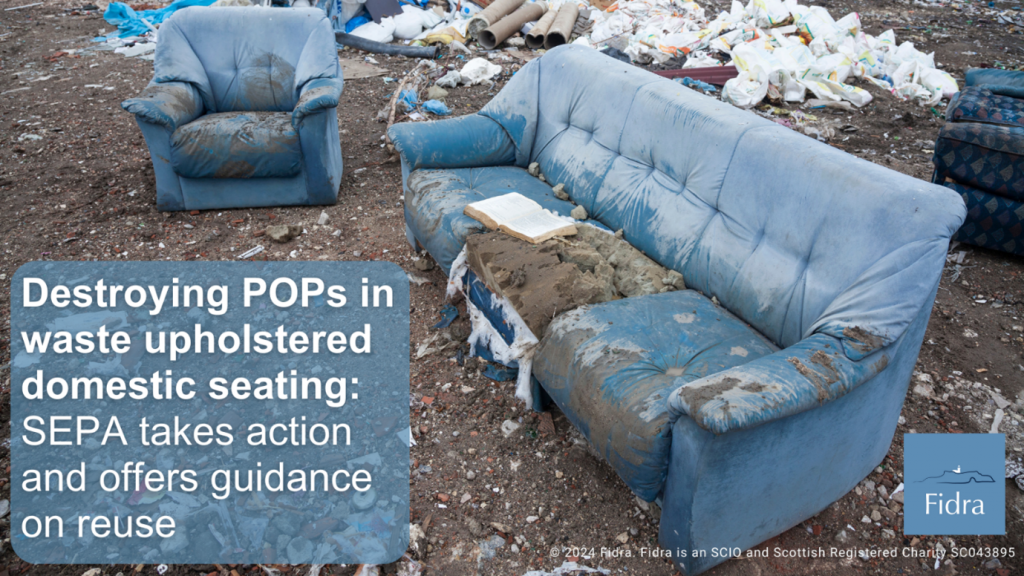Sustainable Fire Safety
The UK’s current approach to fire safety is ineffective and contributes to the global chemical pollution crisis. Chemical flame retardants lost from our furniture and everyday products are now ubiquitous in our environment, fuelling biodiversity loss and impacting our health.
Fidra aims to reduce our reliance on chemical flame retardants and improve chemical data transparency. By improving supply chain traceability, we can reduce chemical pollution, protect wildlife and ensure effective fire safety.
The Problem
Understandably, fire safety is of utmost importance. In the UK, the main driver for the use of chemical flame retardants in domestic furniture is the Furniture and Furnishings (Fire) (Safety) Regulations 1988. Chemical flame retardants are also added to a large proportion of day-to-day manufactured products and materials such as electronics, foam and insulation to help prevent and limit the spread of fires.
Chemistry is rooted in the innovation of flame retardants. Global chemical production has increased fifty-fold since 1950 and is set to treble again by 20501, fueling the chemical pollution crisis. When chemical flame retardants are lost to the environment, they can persist, and place a harmful burden on both environmental and public health. And yet, despite evidence of more effective and sustainable chemical-free alternatives, the government’s ongoing delays in updating fire safety regulations will mean that chemical flame retardants continue to be used unnecessarily in products throughout our homes.
Many chemical flame retardants are known to be inherently persistent in the environment (2,3) and yet the long-term behaviour of these pollutants are largely understudied and unknown. As growing evidence continues to highlight the potentially harmful impacts on public and environmental health, a continual drip of new restrictions are introduced on chemicals that were previously considered safe and added to consumer goods. This is particularly concerning for long-lived items such as mattresses and sofas that are more vulnerable to containing newly banned or restricted chemicals. This was highlighted by the introduction to incinerate waste upholstered domestic seating (WUDS) following new research which found many WUDS items to contain chemicals now restricted under the United Nations Stockholm Convention as Persistent Organic Pollutants (POPs)4.
With the current push to improve product circularity across the UK, we face an ever-increasing problem of hazardous chemicals creating a barrier to safe reuse and recycling. The only way to ensure a safe and successful circular economy is to phase out hazardous chemicals wherever possible, and where chemicals of concern are still used, these must be traceable through full chemical transparency along supply chains.

The Impacts of Chemical Flame Retardants
Deleterious to the Environment
Damaging to Human Health
A Barrier to a Safe Circular Economy
Chemical pollutants put significant pressure on wildlife populations which are already under threat from climate and land-use change.
Flame retardants have been found in wildlife across the globe, from penguins in the south to polar bears in the north. There have even been detected in the eggshells of the Bass Rock gannets, long-term neighbours of Fidra’s hometown, North Berwick.
We are exposed to chemical flame retardants in our homes5. They are added in excessive quantities to our products and accumulate in the dust we can’t help but breath in.
The Cancer Prevention and Education Society outlines the effects of flame retardant exposure to include cancer, neurotoxicity, developmental, behavioural, metabolic and reproductive problems6.
Chemical production outstrips global capacity to effectively assess and monitor their use, leaving public and environmental health vulnerable, and undermining the safety of our circular economy. We therefore cannot hope to achieve a clean and toxic free circular economy without transparency.
“More than 80% of the environmental impact of a product is determined at the design stage7.”
Call to Action
In 2019, a parliamentary inquiry carried out by the Environmental Audit Committee on ‘Toxic Chemicals in Everyday Life8’, heard evidence from a wide range of experts on the growing body of research linking flame retardants to adverse effects on humans and the environment.
The question is not, should we implement change? But why haven’t we implemented change? It is clear we need effective and immediate action to reduce our exposure to harmful flame retardants, safe-guarding both our health and our environment.

Up to 18% of the weight of the mattress on your bed right now could be chemical flame retardants. These chemicals are lost into our homes, our bodies, and the environment, threatening human and environmental health9.
Fidra’s Work
Fidra aims to reduce reliance on harmful chemical flame retardants and improve standards of chemical transparency. We are working alongside the mattress industry to demonstrate pragmatic solutions that ensure safe, effective and sustainable fire safety.
Find out more
References
1. Persson, L., Carney Almroth, B. M., Collins, C. D., Cornell, S., de Wit, C. A., Diamond, M. L., Fantke, P., Hassellöv, M., MacLeod, M., Ryberg, M. W., Søgaard Jørgensen, P., Villarrubia-Gómez, P., Wang, Z., & Hauschild, M. Z. (2022). Outside the Safe Operating Space of the Planetary Boundary for Novel Entities. Environmental Science & Technology, 56(3), 1510–1521. https://doi.org/10.1021/acs.est.1c04158
2. Tian YX, Chen HY, Ma J, Liu QY, Qu YJ, & Zhao WH (2023). A critical review on sources and environmental behavior of organophosphorus flame retardants in the soil: Current knowledge and future perspectives J Hazard Mater 452 131161, https://doi.org/10.1016/j.jhazmat.2023.131161.
3. Kung H-C, Hsieh Y-K, Huang B-W, Cheruiyot NK, & Chang-Chien G-P (2022). An Overview: Organophosphate Flame Retardants in the Atmosphere Aerosol Air Qual Res 22(7) 220148, https://doi.org/10.4209/aaqr.220148.
4. Environment Agency (2022). Manage waste upholstered domestic seating containing POPs Retrieved online October 25, 2023 from: https://www.gov.uk/guidance/manage-waste-upholstered-domestic-seating-containing-pops.
5. Malliari, E., & Kalantzi, O.-I. (2017). Children’s exposure to brominated flame retardants in indoor environments – A review. Environment International, 108, 146–169. https://doi.org/10.1016/j.envint.2017.08.011
6. Carignan, C. C., Mínguez-Alarcón, L., Butt, C. M., Williams, P. L., Meeker, J. D., Stapleton, H. M., Toth, T. L., Ford, J. B., & Hauser, R. (2017). Urinary Concentrations of Organophosphate Flame Retardant Metabolites and Pregnancy Outcomes among Women Undergoing in Vitro Fertilization. Environmental Health Perspectives, 125(8), 087018. https://doi.org/10.1289/EHP1021
7. European Commission (2018). Sustainable Product Policy. https://joint-research-centre.ec.europa.eu/scientific-activities-z/sustainable-product-policy_en
8. Environmental Audit Committee. (2019). Toxic chemicals in everyday life. twnetieth Report of Session 2017-2019. Report HC 180. Parliamentary Copyright House of Commons 2019
9. Stapleton, H., Klosterhaus, S., Eagle, S., Fuh, J., Meeker, J.,Blum, A., Webster, T. (2009). Detection of Organophosphate Flame Retardants in Furniture Foam and U.S. House Dust. Environmental Science & Technology. 43(19). 7490-7495. http://doi.org.10.1021/es9014019



